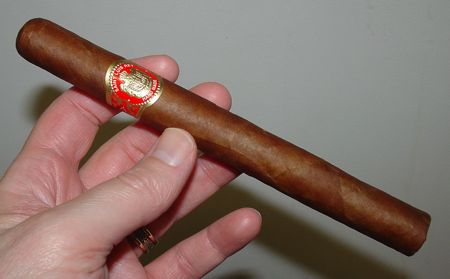This is one of the last of a box of Saint Luis Rey Cazadores that I bought in late 2005 to conduct an aging experiment. Soon after this the Cazadores vitola went out of production. The manufacturer toned down the blend for the other sizes in the line, but this is the original Honduran blend. After reading so much about how well Cuban cigars age, I wanted to see how a full-bodied Non-Cuban cigar would hold up over a few years. After acquiring some aged Camacho Havanas that had become extremely mild over the years I wanted to compare different styles of non-Cuban cigars after a few years of aging.
When I first cracked the box I found the Cazadores to be aggressive, but tasty — woody and spicy with a peppery bite. Two years in long-term parking mellowed the smoke significantly, allowing more distinct flavors of leather and cinnamon to emerge, while still retaining some of the original bite.
It has now been almost five years since I purchased this box, most likely more than five years since they were produced, so it’s time to give them a final assessment.
Construction Notes
The St. Luis Rey Cazadore has not suffered at all from its long cedar nap. The wrapper is just as pretty as it was on opening the box in 2005, and the roll is solid with just a bit of give. One improvement made over time is the burn — these senior smokes are burning righteously, though the ash is still a mite flakey.
Overall construction: Very Good.
Tasting Notes
The first few puffs on the Cazadore are reminiscent of the young cigar — a touch of spice on the tongue — but this sensation quickly dissipates and is replaced by a smooth, almost creamy smoke. The smoke texture is still full in body and has a decent kick, but this feisty Honduran of 2005 has finally matured into a respectable citizen of the world.
When new this cigar’s aroma was almost undetectable amidst the hammering that it gave the palate, but five years later it reveals an enjoyable and subtle spice over an earthy foundation.
The mid-section of the cigar is still hearty, but its spirit has waned over the years. More than anything I enjoy the cedar and light spice on the nose — cinnamon or nutmeg I think — and the smooth earthy flavor. The final section gets a little more serious as the black pepper kicks in again, but the flavor loses complexity and eventually flatlines.
Conclusion
I think these cigars are probably a little past their peak at this point. The flavor isn’t completely washed away yet (as happened with the Camacho Havana after six years) but the complexity of the cigar is waning. The toasty, earthy flavor of this 5 year-old blend is still very enjoyable though, and the soft subtle spices that have emerged in the aroma are a nice surprise.
Aging this now -extinct SLR blend has produced a pronounced change in flavor as well as performance, and each stage of its maturation has revealed a different set of characteristics. That’s what makes aging cigars fun. Leave a comment if you have any suggestions for other blends — especially Non-Cuban cigars — that you think age really well.





